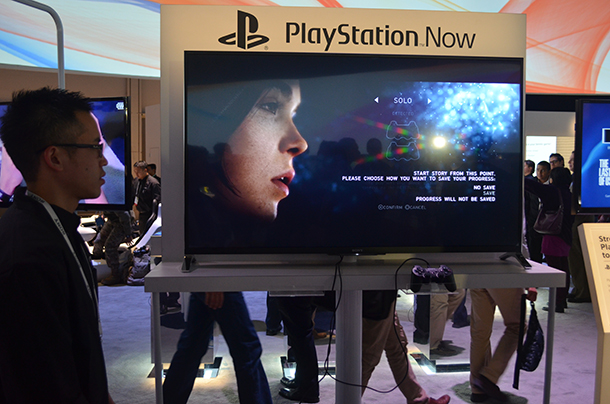
When Sony purchased game streaming service Gaikai two years ago, many of us were excited at the notion that we’d be able to get our hands on potentially a vast library of games at the touch of a button. Not much was known or said until early last year, when the company announced that the service would receive integration into the PlayStation 4. No time frame was given, but we were fine with that. Just get it to us eventually, and we’d be happy.
All caught up? Cool.
Fast forward to this week, and Sony has firmly given us solid details about what is now known as PlayStation Now: it’ll be a subscription service, it’ll work on PS4 and other devices, and we can play old games. Oh, and it’s launching this Summer, with a private beta dropping this month.
But the big question remained: does it work? The simple answer is yes, but there’s much more to understanding what the service is before we get too excited.
We spent some good hands-on time with it at CES this week, poking around at menus and playing games on two of the announced devices, a Sony Bravia and a PS Vita. More devices are coming (the PS4, Xperia phones, and PCs) and the company is working with other manufacturers at integrating Now. All devices will require a DualShock 3 to be paired to play games. If you have a PS4 already then you’re familiar with the capabilities to stream your library to your PS Vita, and the Vita TV will offer a similar experience.
For comparison, rival OnLive has it’s own box for gamers, but also has a very solid PC integration and is available on several TVs and Android devices already. OnLive has the option to use touch controls as well its special paired controller.
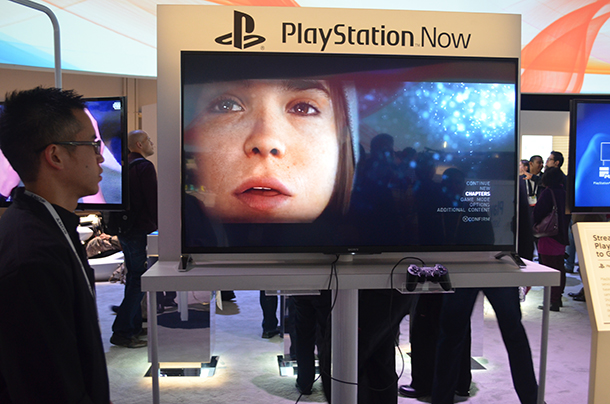
Sony’s representative — let’s call him Sam — who seemed to walk the company line when we asked specific questions, was at least willing to answer a few of our queries. For instance, a DualShock 3 is required to play games not on the Vita. What does that mean? Well, what doesn’t use a DualShock 3? The PS4. Yup, no PS4 games will be streamed through the service, relegating it to a back catalog service. By the time it launches in the Summer, Sony’s PS3 will no longer be a gaming focus for the company, with fewer and fewer titles being released this year.
So you have a back catalog service, which may be fine for the intrepid gamer who wants to pull things back from the PS1 era. Wait, what’s that, Sam? No PS1 games? “Right now we’re focusing on the PlayStation 3. We want to get that catalog going through the service before we look at older consoles. We are curating the titles we offer through Now to give players the games they want, including the newest games.” Well, I guess that’s understandable. But if the classics are already available through PSN, how difficult would it be to put them on the new service? They’re already coded to work through the same architecture, right? I guess “you can still buy a lot of those games through PSN if you want to play them on your Vita and PS3. Right now our focus isn’t on those games.”
Alright, that’s one way to avoid the subject. At least when the games do potentially become available, and we already own them digitally, we’ll be able to play them right away, right? “No. The service isn’t linked to your PSN libraries. This is a separate subscription service.” Oh. That’s… disappointing. We’re essentially buying a lot of those games twice, just to have the ability to stream them. “But, any trophies you do earn in games will go towards your PSN account.” Yay, trophies.
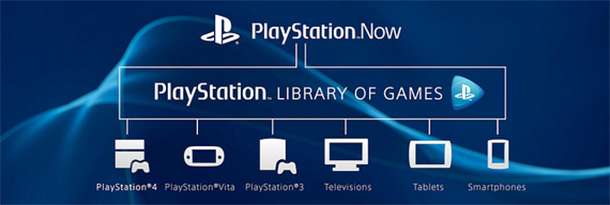
That wasn’t a promising way to start our time with the medium. PS Now will be a subscription service, separate from our PSN libraries and (as we’re being led to believe) separate from PS Plus. With the library being “curated”, that means we’ll be getting the newer games first before any real back catalog, and there won’t be a lot of games for a while either (if ever). “No, we won’t have every PS3 game. We’ll have the best games that people want to play.” That means that you’ll be re-paying for games you probably already own, if you’re a PlayStation 3 owner, just to be able to play them on a different device.
Take a step back, though. That’s not the goal of PS Now, but it may be a gaff by Sony for not explaining it well. PS Now, integrated into Sony Bravias and Xperia phones and (we think) iPads, is aimed at the folks who aren’t PlayStation gamers. It’s for the people who don’t buy consoles to play games, or at all, yet still want to be able to try some great experiences from the PS3. This is Sony’s transition of PlayStation from a console to a service, with PS Now clearly as the backbone. There may not be a PlayStation 5, just an ever evolving PS Now library that plays on every device.
So not a bad idea, just not communicated well. But that’s thinking into the future. Let’s chat about what we actually got to try.
There were four games on display at the booth: The Last of Us, God of War: Ascension, Puppeteer, and Beyond: Two Souls. On the Bravia, we played through a stage of Last of Us before switching over to Beyond. We were handed a Dual Shock 3 and told to go shoot guys and stuff. Sam couldn’t tell us if the Bravia was networked via LAN or wirelessly, but we didn’t really notice much lag with Last of Us. In fact, turning and pivoting was very smooth, and our button presses were accurate and timely. Pretty good and very promising.
“Multiplayer works, too.” Oh? Do tell me more, Sam. “PS Now allows connections to disc-based games for multiplayer. Someone who owns Last of Us on a disc on their PS3 would never know they were playing against someone who was solely using Now.” That comes off as a bullish idea, but it’s one that can help expand the value of the service.
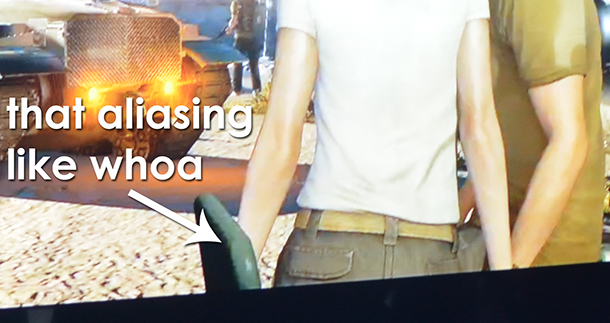
Now, I don’t know how close you may or may not sit to your television when playing games, but I split my I time from 5 feet away (when things are intense) or on a couch 8-10 feet away, when I’m playing something more laid back. At our demo we were placed about 3 feet from the Bravia. It was at this vantage point that the aliasing and sub-par visual fidelity was blaring. It clearly wasn’t coming across as 1080p, and barely seemed to hit 720p at times. It looked like what the technology actually is: a steaming video of a game, not the game data itself. With a game lauded for its visuals, this didn’t do it any good. If you’re someone who draws lines during the recent 1080p drama, then this will definitely affect your perception. But then again, it may be fine for a casual, non PlayStation owner.
We asked to see what Beyond looked like on the service, and Sam did his best to accommodate us. “Go back to the home menu” he told the booth associate. Backing out of a game is simple, with the click of just a couple of button presses getting us back to the Now home menu. “The menu design isn’t final,” Sam says of the PSN Store-themed layout. It looked clean and snappy, and had the familiar feel of a modern PlayStation product.
But then. Then reality hit us that this was a streaming service, hosted through a magic cloud and susceptible to interlag and notworks. Selecting Beyond began a connection to the Now servers. About thirty seconds later, the connection verified and a second connection to the actual game began. That took all of twenty or so seconds to accomplish before the title screen popped up. “Normally this would also begin with a network connection test, too,” says Sam. Oh, so more connections. And more time waiting, too. Once we hit “start” on Beyond‘s menu, a new menu had to load to select the mission we were to play. This took well over a minute and a half, with mission titles swirling around the screen while we waited. And waited. And waited. In fact, it took so long that we opted to move over to the Vita version and try the service there.
As the Vita loaded up, my eyes would randomly peak at the Bravia screen. Beyond didn’t load until our demo was over. Hashtag sadface.
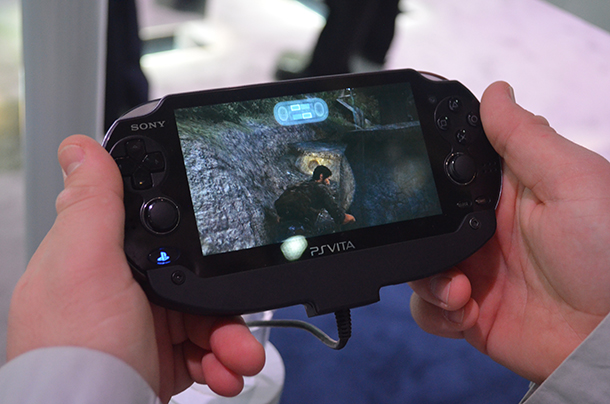
“We’re just having some network issues because of the show floor.” That’s expected, Sam, but this should have been tight. Especially troubling was that the actual server was hosted in a different part of the CES show floor, with just a couple devices connecting to it, so distance shouldn’t be an issue. It’ll be interesting to see how the service holds up when thousands (millions?) of people try to connect at once.
On the Vita, which connects to Now wirelessly, we had an opposite experience than what transpired with the Bravia. Playing Last of Us, the visuals were great on the small screen. Even if there was some aliasing or rasterizing, it wasn’t noticeable. But the lag? Oh, that lag. I noticed a nearly half-second lag between my stick movements and button presses and the action on the screen. Not good. Add to that the control scheme utilizing the four quadrants of the Vita’s rear touch to mimic the L2, L3, R2 and R3 button presses (of which PS4 owners who stream their games to the Vita already are familiar with) and you can see a momentum killer, even for those who are ambidextrous. I’m not. My fingers cramp up an don’t stretch like how Sony asks them to, and the concept on the Vita becomes an accessibility nightmare.
But it worked. The service worked. It wasn’t magic — it’s near identical in quality and delivery as OnLive — and it doesn’t come off as anything revolutionary, but playing Last of Us on a TV without needing a PS3 could be a great way for casual gamers to pick up some classics, depending on the subscription price Sony settles on. And if games Madden or Call of Duty appear on it, it might be perfect for that gamer that doesn’t want to plop money down on a console just to play the game everyone is talking about, or the two or three games they may really want to play.
Missing out on my already existing PSN library does hurt, though. I don’t want to repay for something I already own, without my saves transferring over too. And if we’re only looking at PS3 games (which will quickly become obsolete when the PS4 becomes more of a force this year) then the value diminishes a bit. Casual gamers will eventually want the new PS4 games to stream, which Sony hasn’t announced yet. And classic games may be fine, but if we already own them and Sony isn’t focusing on delivering them any time soon, then a few PS3 games I already own may not be enough to switch me over.
There is promise in concept, and a lot of work that Sony has yet to do before it launches and evolves it over time. But baby steps are baby steps, and these aren’t toddler leaps. Yet.
All images are ours. Taken by our cameras.


No Comments